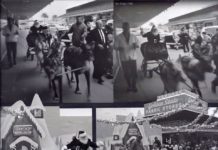
The Clairemont Town Council recently forwarded a message about plans for a 2020 ground breaking to modernize the Lindbergh Schweitzer Elementary School site. There is also a movement to rename the school:
The site governance team (SGT), which consists of students, families, staff and some community members, has a list of recommended names in order of preference:
- Clairemont Canyon Preparatory Academy
- Clairemont Canyon Academy
- Clairemont Canyon Elementary
First, where is the canyon? Lindbergh Schweitzer is built on the mesa. The nearest canyon to the campus, the terminus of Boyd Canyon, is five or six blocks to the southwest. Few people have heard of Boyd Canyon.
So, who came up with that name? Clairemont Canyon sounds more like a boring strip mall or nondescript apartment complex. It is difficult to imagine that such an unimaginative name came from community input.
Second, why is it necessary to change the name of a consolidated school named after two men considered to be major international heroes?
In 1927, Charles Lindbergh, “The Lone Eagle,” was the first person to fly solo across the Atlantic Ocean from New York to Paris. His plane, Ryan NYP, The Spirit of St. Louis, was built in San Diego. Instantly, he became recognized worldwide as the symbol of American individuality and exceptionalism.
But with fame came tragedy and controversy. His infant son was kidnapped and murdered in 1932. Prior to World War II, he was a staunch isolationist and supported Hitler’s Germany. President Franklin Roosevelt publicly rebuked him for his beliefs. Interestingly, Lindbergh’s father, a former Minnesota congressman, was one of the few members of the House of Representatives to oppose America’s entry into World War I.
After Pearl Harbor, Lindbergh tried to reenlist in the Army Air Forces, but his request was denied. He became a technical advisor who helped improve the performance of combat aircraft and eventually flew fifty combat missions as a civilian in the Pacific.
In his day, Lindbergh was known for his anti-Bolshevik, anti-Semitic and racist views. In 1945, serving in a naval advisory role, he was horrified by the Nazi concentration camps he encountered. After the war, despite being married to his loving wife, Anne Morrow, he secretly fathered seven children by three German mistresses.
At the dawn of celebrity, Charles Lindbergh soared from obscurity to become an American icon, but his feet were made of clay. He led a life full of contradictions. His loyal wife, unaware of his other families, claimed that her husband was misunderstood. In their final years together, the Lindberghs were dedicated to environmental causes around the globe.
The other man, Albert Schweitzer, was a French medical missionary who devoted over fifty years to treat illness and poverty in Africa. He was awarded the 1952 Nobel Peace Prize. As a young man with a promising future in theology and music, he instead decided to follow the words of Jesus: “Heal the sick, cleanse the lepers, raise the dead, cast out devils; freely ye have received, freely give. Provide neither gold, nor silver, nor brass in your purses.”
After completing compulsory military obligation and serving as a curate for the Church of Saint-Nicholas in Strasbourg, Schweitzer entered medical school at the age of 31 and later founded a hospital in Lambarene in French Equatorial Africa (Gabon). With his equally committed nurse wife, Helene Breslau, they treated patients with leprosy, dysentery, elephantiasis, sleeping sickness, malaria, yellow fever and wounds received from wild animals.
When he died in 1965 at age 90, his hospital and deeds were world-famous. The Schweitzer Hospital had 350 beds and the compound was home to a leper colony of 200 patients. His life was built on the principle of “reverence for life and the religious and ethical imperatives of helping others.”
In recent years, many of the good doctor’s comments, common for his time, have been labeled as racist and paternalistic. We live in an era where the past is harshly judged by today’s enlightened standards. Times change; truths change. Although our legal system is based on a presumption of innocence, today there is a presumption of guilt.
What is the role of our education system in this process? What are the limits of educators and their agendas?
Third, it is ironic to note that in 1971, Sunshine School, at the corner of Balboa Avenue and Hathaway Street, was renamed in honor of Albert Schweitzer for his contributions to humanity.
What was Sunshine School? In 1935, Sunshine School for disabled students opened in Logan Heights. Its purpose was “to bring sunshine to handicapped students.” The original site was demolished in 1954 for the construction of the Escondido Freeway (CA 15) and the school eventually found a permanent home in East Clairemont.
If Lindbergh Schweitzer School must be renamed, why not name it Sunshine School with a stated mission to bring sunshine to all students?
The goals and history of Sunshine School are as relevant today as they were in 1935.
According to the Clairemont Town Council message, “If you have any input with regard to the name change, please contact Karin Wehsener (teacher, community member, and SGT member) at kwehsener@sandi.net.”



